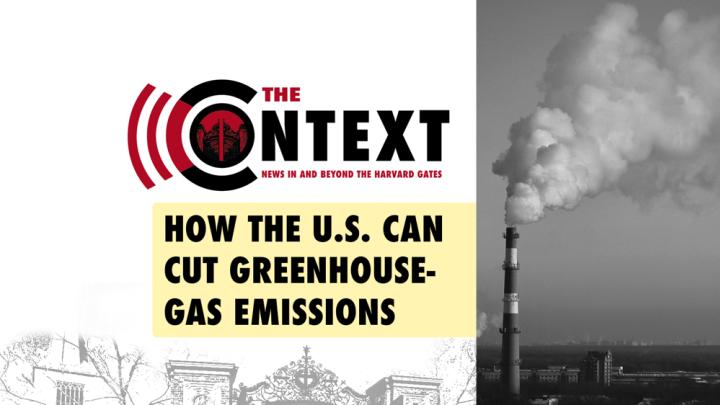This is the ninth post of "The Context"—a biweekly series of archival stories—offering our readers a useful background to some of the most important subjects in the news today. We hope you enjoy it.
Can the United States reduce its contribution to climate change as quickly as President Joe Biden has promised? In April, after re-joining the Paris Agreement, the president set a U.S. goal of reducing its greenhouse-gas emissions by 50 percent from 2005 levels by 2030. In a recent article in The Atlantic, writer Robinson Meyer evaluates this promise, analyzing how different polices could enable the country to meet the goal—or fall short.
Already, according to Meyer, the United States has cut its emissions by about 20 percent since 2005. If current policies are simply maintained, emissions will likely drop 6 percent more by 2030. Of the remaining 24 percent reduction needed, the biggest portion of will likely come from the power sector. Generating electricity by combusting fossil fuels will alone produce 1.5 billion tons of greenhouse gases this year (of more than five billion tons nationwide), but the sector also has “the opportunity for the biggest, fastest reductions.” If the White House meets its goal of 80 percent reductions from the power sector, through the Clean Electricity Payment Program—which would compensate suppliers who provide more clean energy to customers—and other clean-energy initiatives, that would get the country 11 percentage points closer to its overall goal. The remaining reductions, which would be more difficult to achieve, include electrifying medium- and heavy-duty vehicles (and passenger ones), capturing carbon dioxide from facilities used in industrial processes like the production of cement and steel, and upgrading and improving heating systems.
Harvard Magazine has published many articles on policy solutions to limit climate change—a mix of staff-reported journalism and essays contributed by faculty experts. A 2011 feature by Butler professor of environmental studies Michael McElroy, “Time to Electrify,” advocates a few notable fixes—many of which have been implemented. One of McElroy’s key points was that the “intrinsically inefficient” combustion engine had to be replaced. “Less than a quarter of the energy consumed is used to drive the vehicle,” he wrote. To harness electricity from wind instead of coal, he recommended constructing a network of high-voltage direct-current supply lines that would connect regions of high demand with regions or high potential supply “from coast to coast and from border to border.” To help accommodate the variable nature of wind power, McElroy suggested a two-way connection between utilities and customers that could enables cars to be charged when excess electricity was available—and to serve as a power source (their batteries as reservoirs) when electricity was in short supply.
For a discussion of a carbon tax—and a comparison of taxation with cap-and-trade systems and new rules and regulations—I’d recommend this interview with Morris University Professor Dale Jorgenson. “[I]n order to achieve the double dividend—curbing emissions while simultaneously achieving economic growth—you have to collect the tax and recycle the revenue,” Jorgenson said. The interview shows how he thinks about the advantages and disadvantages of increased taxes on heating, electricity, and transportation:
What are you trying to achieve? You want a lower level of carbon in the atmosphere so that you can avoid global warming. That affects all individuals in the same way because everybody’s exposed to the effects of climate change. So you have to ask yourself, what is the optimal rate for everybody, for the whole world economy?
This recent feature by managing editor Jonathan Shaw discusses some of the possible solutions offered above, but also a novel one: climate geoengineering. Ramsey professor of political economy Richard Zeckhauser and professor of the practice of public policy Joseph Aldy describe solar geoengineering (blocking 1 to 2 percent of the sunlight that reaches Earth) as an “awful solution”—but one that might be needed to moderate global temperatures as the world struggles to limit carbon emissions.
The University itself has pledged a 2050 “fossil-fuel free” goal. This analysis is a good guide to Harvard Management Company’s effort to achieve “net-zero” endowment holdings by that date.
More from “The Context”
- The Gig Economy and the Future of Work: Our best work on employment's present and future
- Affirmative Action and Harvard: Recent and archival work on litigation in admissions
- Life on the Mesopotamian Marshes—and the Specter of Drought: Past work on water and human intervention
- How Exercise Gives Us Purpose: Reviewing our best articles on exercise
- Arthur C. Brooks on "Revenge Bedtime Procrastiination": Presenting our best archival work on sleep
- Universities Pushed to Reckon with Slavery: Students and activists advocate for institutional change.
- Simpsons Writer John Swartzwelder on Comedy: Sharing some of our best work on comedians and their craft
- Daniel Lieberman on Food Addiction: Framing the news with our best articles on diet and health









